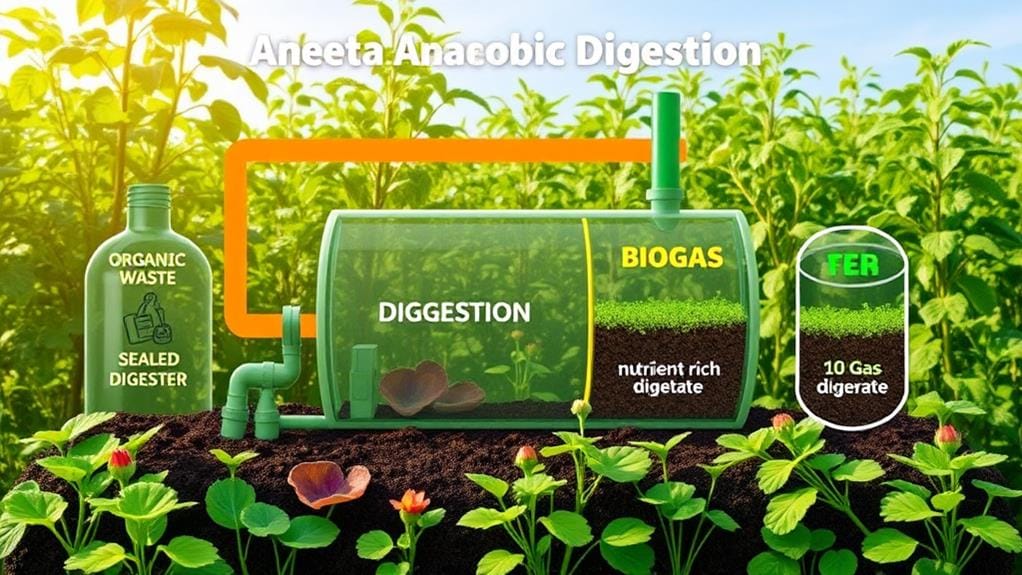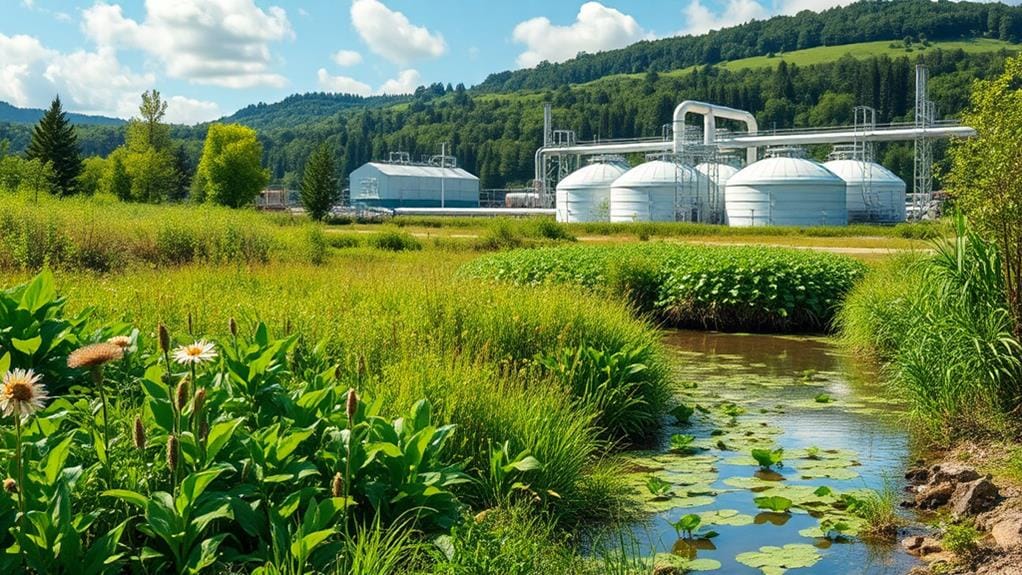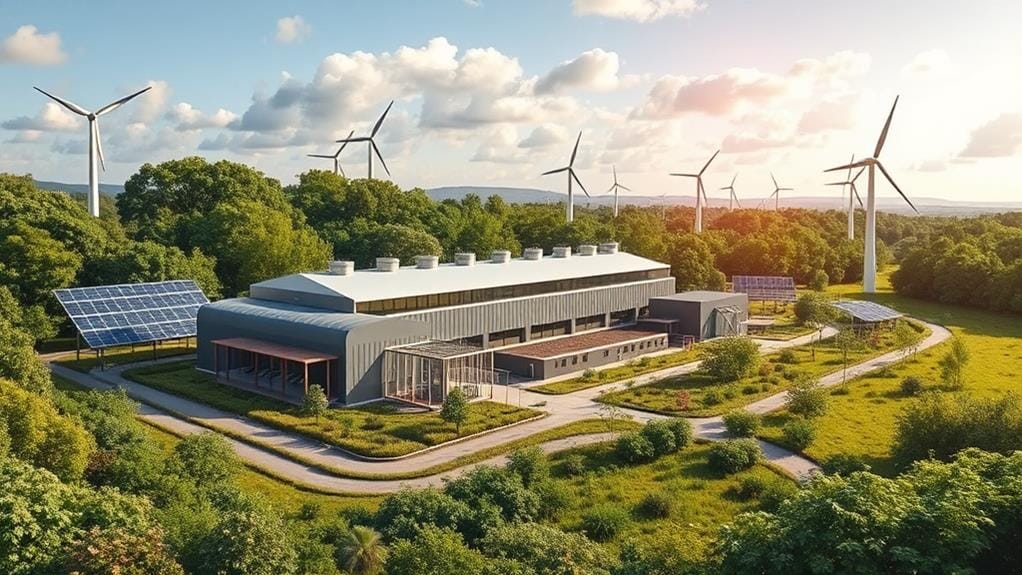Transforming waste into energy through anaerobic digestion is vital for mitigating environmental impacts while producing renewable energy. This process effectively converts organic waste into biogas, containing 50-75% methane, through four stages: hydrolysis, acidogenesis, acetogenesis, and methanogenesis. By diverting waste from landfills, we reduce methane emissions, which account for around 10% of U.S. emissions from livestock manure, thereby contributing to climate goals. Additionally, the digestate produced serves as a nutrient-rich fertilizer, enhancing soil health. The potential economic benefits include creating approximately 335,000 temporary and 23,000 permanent jobs while generating over 13 million megawatt-hours annually, further emphasizing its value. There's much more to reflect on this topic.
Key Takeaways
- Transforms organic waste into renewable energy, reducing landfill waste and supporting climate mitigation efforts.
- Decreases methane emissions significantly, addressing a major contributor to greenhouse gases from agriculture.
- Produces nutrient-rich fertilizers that enhance soil health, promoting sustainable farming practices.
- Generates economic benefits, creating jobs and providing a sustainable energy source from waste.
- Supports a circular economy by recycling organic waste, reducing reliance on fossil fuels, and contributing to energy independence.
Understanding Anaerobic Digestion
Anaerobic digestion transforms organic waste into valuable resources, and it's a process we should all understand. This anaerobic digestion process involves microorganisms breaking down organic matter in the absence of oxygen, leading to the production of biogas, primarily composed of methane and carbon dioxide. The process unfolds in four stages: hydrolysis, acidogenesis, acetogenesis, and methanogenesis, each vital for converting complex organic materials into simpler, energy-rich methane. Importantly, this method effectively reduces the volume of organic waste directed to landfills, markedly decreasing methane emissions—a potent greenhouse gas. Additionally, the digestate produced serves as a nutrient-rich fertilizer, enhancing agricultural practices while contributing to sustainable waste management and renewable energy production. Understanding these concepts is essential for fostering a more sustainable future.
The Pre-Treatment Process

In our exploration of the pre-treatment process, we recognize its crucial role in maximizing anaerobic digestion systems by ensuring that only suitable biowaste enters the process. By employing methods such as microwaving, heating, and milling, we can enhance the degradability of food waste, thereby increasing its surface area and facilitating microbial breakdown. This effective pre-treatment not only improves biogas yields but also maintains ideal conditions for microbial activity, underscoring its importance in the overall efficiency of the anaerobic digestion process.
Importance of Pre-Treatment
Effective waste management hinges on the careful preparation of food waste before it enters the anaerobic digestion process. Pre-treatment plays an essential role in enhancing the efficiency of this process, guaranteeing that only suitable biowaste is processed. Here are some key aspects we should consider:
- Removal of Packaging: This step prevents contamination and guarantees only organic materials enter the digestion tank.
- Size Reduction: Techniques like milling increase surface area, promoting effective microbial access.
- Enhanced Degradability: Methods such as heating accelerate degradation, leading to higher biogas yields.
- Operational Efficiency: Proper pre-treatment contributes to peak energy production, reducing challenges in waste management.
Methods of Pre-Treatment
While preparing food waste for anaerobic digestion, we can enhance the process greatly through various pre-treatment methods. These methods, such as microwaving, heating, and milling, help increase the surface area of organic materials, facilitating easier degradation by microorganisms. This not only boosts microbial activity but also markedly improves the efficiency of biogas production. By effectively removing packaging and non-food materials, we guarantee that only suitable materials enter the anaerobic digestion tank, optimizing the overall process.
| Pre-Treatment Method | Benefits | Impact on Biogas Production |
|---|---|---|
| Microwaving | Increases surface area | Accelerates degradation |
| Heating | Enhances microbial activity | Boosts efficiency |
| Milling | Reduces size of waste | Improves overall yield |
Benefits for Anaerobic Digestion
Pre-treatment methods not only prepare food waste for anaerobic digestion but also bring significant benefits to the overall process. By implementing effective pre-treatment, we can enhance biogas production and optimize energy recovery. The key benefits include:
- Increased Degradability: Methods like microwaving and heating boost the breakdown of organic waste.
- Higher Biogas Yields: Size reduction leads to enhanced surface area, improving the efficiency of biogas production.
- Reduced Contaminants: Ensuring only suitable organic waste enters the AD tank minimizes risks of contaminants that could hinder performance.
- Nutrient-Rich Digestate: Effective pre-treatment supports the production of digestate, which is valuable for agricultural use.
Together, these advantages make the pre-treatment process essential for maximizing renewable energy and minimizing methane emissions in anaerobic digestion systems.
Stages of Anaerobic Digestion

In exploring the stages of anaerobic digestion, we recognize that this complex process unfolds through four distinct phases: hydrolysis, acidogenesis, acetogenesis, and methanogenesis. Each stage plays an essential role in the transformation of organic matter, beginning with the breakdown of complex polymers into simpler monomers during hydrolysis, and culminating in the generation of biogas in the methanogenesis phase. As we move through these stages, we'll examine the specifics of each phase, the production of digestate, and the benefits that arise from its utilization.
Hydrolysis Phase Explained
How does the hydrolysis phase set the stage for efficient anaerobic digestion? This initial stage is essential, as hydrolytic bacteria break down complex organic materials, such as carbohydrates, proteins, and fats, into simpler monomers like sugars, amino acids, and fatty acids. The efficiency of this phase directly influences biogas production. Key factors include:
- Substrate Preparation: Effective pre-treatment, like milling or heating, enhances surface area for microbial action.
- Environmental Conditions: Ideal temperature, pH, and moisture promote faster hydrolysis rates.
- Microbial Activity: Hydrolytic bacteria play a significant role in decomposing long-chain polymers.
- Organic Matter Bioavailability: Increased breakdown improves the availability of organic materials for subsequent microbial processes in anaerobic digestion.
Together, these elements guarantee a successful transformation of waste into energy.
Methanogenesis Process Overview
After hydrolysis breaks down complex organic materials into simpler compounds, the next significant phase of anaerobic digestion is methanogenesis. In this vital stage, specialized microorganisms, known as methanogens, convert volatile fatty acids and other byproducts into methane and carbon dioxide, with methane making up 50-75% of the produced biogas. This transformation occurs in a low-oxygen environment, essential for turning organic matter into usable renewable energy. During methanogenesis, water is also produced as a byproduct, contributing further to energy generation. The efficiency of this process hinges on ideal conditions, including temperature, pH, and the specific microbial communities present, typically maintained between 30-38 degrees Celsius, ensuring effective biogas production and sustainable waste management practices.
Digestate Utilization Benefits
Harnessing the potential of digestate, the byproduct of anaerobic digestion, offers numerous benefits that can considerably enhance agricultural practices. By leveraging both solid and liquid digestate, we can support sustainable farming and nutrient recycling. Here are four key advantages we can expect:
- Organic Fertilizer: Liquid digestate is nutrient-rich, providing essential nitrogen, phosphorus, and potassium, thereby reducing our reliance on synthetic fertilizers.
- Soil Health: The solid digestate enhances soil quality, improving crop yields and overall agricultural productivity.
- Animal Bedding: Solid digestate can serve as eco-friendly bedding, minimizing waste disposal issues.
- Revenue Streams: Selling digestate products can create additional revenue streams for biogas projects, improving their economic viability while reducing environmental impact.
Biogas Applications

Biogas applications offer a versatile solution in our pursuit of sustainable energy. By harnessing the power of anaerobic digestion, we can transform food waste into valuable energy sources. Biogas, primarily composed of 50-75% methane, plays a key role in energy diversification, serving for heating, electricity generation, and renewable vehicle fuel. Combined Heat and Power (CHP) systems utilize biogas efficiently, generating both electricity and heat. In developing nations, small biodigesters provide essential energy for cooking and heating, enhancing energy access. Additionally, purifying biogas into Renewable Natural Gas (RNG) allows it to meet natural gas standards, creating additional revenue streams.
| Application Type | Benefits | Impact on Emissions |
|---|---|---|
| Heating | Reduces fossil fuel dependency | Lowers greenhouse gas emissions |
| Electricity Generation | Sustainable energy source | Offsets significant emissions |
| Vehicle Fuel | Renewable alternative to fossil fuels | Enhances energy diversification |
| CHP Systems | Efficient dual-purpose energy solution | Minimizes environmental impact |
Environmental Benefits

While many energy solutions contribute to sustainability, anaerobic digestion stands out for its considerable environmental benefits. By harnessing this innovative process, we can effectively tackle pressing issues like food waste and greenhouse gas emissions. Here's how anaerobic digestion positively impacts our environment:
- It reduces food waste in landfills, which account for 21% of U.S. waste, thereby mitigating greenhouse gas emissions from decomposition.
- It can decrease methane emissions by up to 99%, markedly addressing the 10% of U.S. methane emissions from livestock manure.
- It transforms organic waste into renewable energy, supporting climate change mitigation and renewable energy goals.
- It produces nutrient-rich fertilizers that enhance soil health and promote sustainable farming practices, fostering a circular economy.
Economic Advantages

Anaerobic digestion offers considerable economic advantages that can benefit communities and businesses alike. By converting organic waste into biogas, we can create a sustainable energy source that supports energy generation and enhances economic resilience. Although installation costs for digesters can reach up to $8 million, funding from agencies like the USDA and EPA, along with incentives from the Inflation Reduction Act, can greatly alleviate these expenses. Additionally, the biogas sector can generate approximately 335,000 temporary jobs and 23,000 permanent jobs, fostering local economic growth. With an estimated potential of over 13 million megawatt-hours of energy annually from 8,241 livestock biogas systems in the U.S., expanding anaerobic digestion presents a lucrative opportunity for diverse sectors and communities.
Policy Support and Growth

Effective policy support is essential for the growth of anaerobic digestion systems, ensuring that we can harness the full potential of this renewable energy source. To truly foster an environment conducive to investment and sustainability, we must emphasize:
- The Renewable Fuel Standard, which promotes biogas as a viable renewable energy source.
- State-level policies, including tax credits and grants, that enhance the financial viability of projects.
- Funding initiatives, like the Farm Bill energy title, that encourage innovation in the sector.
- Collaborative efforts between government, farmers, and industries to optimize biogas systems.
Through targeted government action, we can greatly expand biogas systems, potentially contributing up to 10% of U.S. natural gas consumption from renewable natural gas produced from biogas, paving the way for a sustainable energy future.
Future of Biogas Systems

The future of biogas systems holds immense promise, with the potential to revolutionize how we harness renewable energy from waste. By leveraging anaerobic digestion of food waste and livestock manure, we could see over 13 million megawatt-hours of energy generated annually in the U.S. alone. As we advance biogas technologies, collaboration among farmers, industries, and government entities will be vital for optimizing production and efficiency, addressing pressing environmental issues like methane emissions. Importantly, this growth supports a circular economy, turning waste into a valuable resource while creating an estimated 335,000 temporary and 23,000 permanent jobs. Together, we can drive forward the adoption of biogas systems, aligning our efforts with sustainability goals and enhancing our collective well-being.
Frequently Asked Questions
What Are the Advantages of Anaerobic Digestion of Waste?
We see numerous advantages in anaerobic digestion: it boosts energy production, enhances waste management, recovers nutrients, reduces greenhouse gases, and fosters community engagement, all while offering economic benefits and showcasing scalability potential through technological advancements.
What Is Anaerobic Digestion for Waste to Energy?
Anaerobic digestion's all about harnessing microbial processes for biogas production from organic waste. By embracing energy recovery and nutrient recycling, we're supporting sustainable practices that reduce greenhouse gas emissions and enhance waste management for our communities.
What Is the Purpose of Anaerobic Digestion in Wastewater Treatment?
As the saying goes, "One man's trash is another man's treasure." In wastewater management, microbial activity boosts treatment efficiency, aiding biogas production and nutrient recovery, while enhancing energy sustainability and minimizing environmental impact, benefiting our community together.
Why Is Anaerobic Digestion Better Than Composting?
When we compare anaerobic digestion to composting, we see benefits in process efficiency, energy production, and nutrient recovery. Plus, it offers better odor control and lower environmental impact, making it a community-friendly choice for sustainable waste management.




